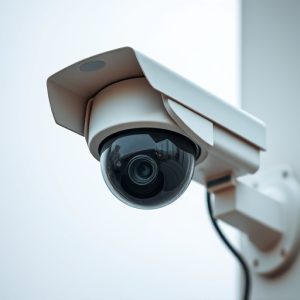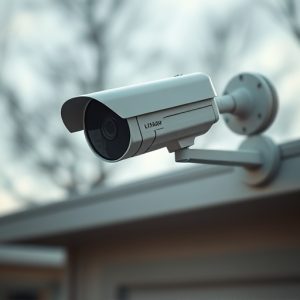Unmasking Fake Security Cameras: Spotting & Preventing Domed Bulb Traps
Fake dome bullet cameras, despite looking authentic, are placed strategically but mistakenly in obvi…….
Fake dome bullet cameras, despite looking authentic, are placed strategically but mistakenly in obvious locations by scammers to mislead homeowners and businesses. To avoid scams, consider subtle placement like high on walls or ceilings, look for haphazard wiring, check for unique identifiers, assess professional design cues, and comply with local laws regarding surveillance equipment placement and maintenance for effective security.
In today’s digital age, homeowners are increasingly turning to security monitoring systems for peace of mind. However, a growing trend has emerged: the proliferation of fake dome bullet cameras, designed to look real but lacking essential security features. This article delves into the world of these deceptive devices, guiding readers through understanding their mechanics, identifying placement mistakes, and employing strategies to detect fakes. We explore visual cues, legal implications, and best practices for homeowners seeking genuine security solutions.
- Understanding Fake Security Monitoring Devices
- Identifying Dome Bullet Cameras: Common Placement Mistakes
- Strategies for Effective Fake Camera Setup Detection
- Real vs Fake: Visual Clues and Red Flags
- Legal Implications and Best Practices for Homeowners
Understanding Fake Security Monitoring Devices
Fake security monitoring devices, often disguised as legitimate surveillance equipment, are a growing concern in home and business security. These fraudulent setups typically include fake dome bullet cameras, strategically placed to mimic real security systems. Scammers use these decoys to lure unsuspecting victims into believing their properties are under constant watch, enticing them to part with sensitive information or fall victim to other forms of fraud.
Understanding the common placement of fake dome bullet cameras is key to identifying and avoiding such scams. These cameras are often mounted in obvious yet seemingly innocuous locations, such as on walls, ceilings, or near entry points. They may even come with sophisticated-looking mounting brackets and cables, further enhancing their authenticity. However, a closer inspection usually reveals telltale signs of their artificiality, like irregular shapes, poor image quality, or unusual features that don’t align with genuine security camera designs.
Identifying Dome Bullet Cameras: Common Placement Mistakes
Many individuals set up fake security monitoring devices, including dome bullet cameras, to deter potential intruders or simply for peace of mind. However, proper placement is key to making these devices effective. A common mistake is placing them in obvious locations, such as near main entrances or windows, where their presence might be easily spotted and quickly countered by determined criminals. Instead, consider more subtle and strategic positions.
For instance, dome bullet cameras can be discreetly installed high up on walls or ceilings, offering a bird’s-eye view of the area without drawing too much attention. They should also be positioned to capture hard-to-see angles, like corners or blind spots behind furniture. This way, potential intruders might feel they’re under constant surveillance, even if they can’t see the camera itself, enhancing the overall security of your property.
Strategies for Effective Fake Camera Setup Detection
Detecting a fake security camera setup requires a strategic approach, especially when dealing with common fakes like dome or bullet cameras. One effective method is to examine the placement and configuration of these devices. Real security cameras are typically positioned at strategic points around a property, offering comprehensive coverage. However, fake cameras often end up in obvious, static locations, such as being glued to walls or ceilings, lacking any strategic advantage.
Additionally, checking for inconsistencies in the wiring and connections can be a giveaway. Professional security systems have well-organized, labeled, and secure cables, while fake setups may have exposed wires or haphazard connections. Advanced users might also look for unique identifiers or serial numbers, as genuine cameras from reputable manufacturers usually have these, which can help verify their authenticity.
Real vs Fake: Visual Clues and Red Flags
When spotting a fake security monitoring device, such as a dome bullet camera, pay close attention to its visual cues. Authentic cameras often have sleek, professional designs with no visible signs of tampering or cheap materials. They are typically mounted securely, with no loose connections or uneven positioning—a common red flag for fakes. Look for subtle branding or model numbers on the device, which can be checked against the manufacturer’s genuine products.
Red flags may include obvious misalignments, poorly executed paint jobs, or inconsistent screw sizes and types. Fake dome bullet cameras might also have distorted or poor-quality video feeds. In contrast, real security cameras provide clear, sharp images, often with advanced features like motion detection and night vision capabilities. Proper camera placement is another indicator; professional installations consider factors like line of sight, angle, and coverage areas to ensure optimal surveillance, while fake setups may be haphazardly placed without regard for these details.
Legal Implications and Best Practices for Homeowners
When setting up a fake security monitoring device, homeowners should be aware of the legal implications and best practices to ensure compliance and personal safety. While some regions have specific laws governing surveillance equipment, even if a system appears innocuous like a fake dome bullet camera, it’s crucial to understand local regulations. For instance, many jurisdictions require notification to residents or property owners before certain types of cameras are installed nearby.
Best practices dictate transparency and responsible use. Homeowners should avoid placing these devices in areas that invade privacy excessively, such as bedrooms or bathrooms, without explicit consent from occupants. Additionally, securing the device properly is essential to prevent tampering or unauthorized access, which could lead to false alarms or security breaches. Regular maintenance and updates of the system can help ensure its integrity and effectiveness in deterring potential intruders.
Fake security monitoring devices, particularly dome bullet cameras, can be easily spotted with careful observation. By understanding common placement mistakes and visual clues, homeowners can effectively detect these fakes. Implement strategies for effective detection and stay informed about legal implications to ensure your home’s true security. Remember, the right setup goes beyond aesthetics; it involves strategic placement to deter potential intruders.


